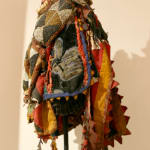Yoruba Wooden Egungun Headdress, 19th Century CE - 20th Century CE
Wood and Mixed Media
10 x 18
PF.5017
Further images
Masquerades in honor of ancestors are known as Egungun or 'powers concealed'. This literal meaning also describes the costume worn by the dancers whose entire body is covered by very...
Masquerades in honor of ancestors are known as Egungun or "powers concealed". This literal meaning also describes the costume worn by the dancers whose entire body is covered by very elaborate layers of cloth. An egungun costume is multi-layered arrangement of colored cloth and beaded panels piled on top of one another, often kept in a family for generations. This fascinating janus headed figure wears an egungun costume based on the same principal as those which cover the full body. A beaded panel in alternating zig-zag pattern of black and white adds a sense of energy and vibrant movement. White, black and golden triangles (symbols of the regenerative forces in nature) occupy another panel. Around the neck of the twin heads is a string of cowrie beads. All of these accouterments are symbols of wealth and prestige. The heads themselves are similar in style to ibeji figures, and each shares a crest of vertical 'prongs'. By dancing in an opulent costume a dancer honors his ancestors, and at the same time proclaims the wealth and status of his family.





